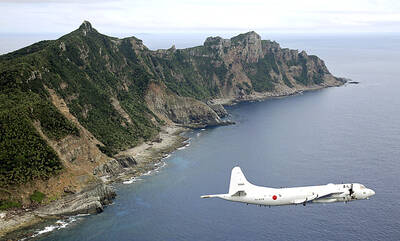US and Chinese military officials will hold talks on rules of behavior at the Pentagon today and tomorrow, a US official said, days after the US denounced what it called a “dangerous” Chinese jet intercept of a US Navy patrol plane.
On Tuesday last week, a Chinese fighter pilot flew acrobatic maneuvers around the US Navy’s P-8 Poseidon anti-submarine and reconnaissance plane, crossing over and under it in international airspace over the South China Sea, the Pentagon said.
At one point, the jet flew wingtip-to-wingtip about 9m from the Poseidon, then performed a barrel roll over the top of it.
The US defense official said other close intercepts occurred in March, April and May.
While this week’s discussions at the Pentagon were planned long before the recent incidents, they touch on issues at the core of the US concerns about Chinese military behavior: that a Chinese provocation could spiral into a broader crisis sparked by a military miscalculation in the disputed territory.
China’s sovereignty claims over the strategic stretch of mineral-rich water off its southern coast and to the east of mainland Southeast Asia set it directly against US allies Vietnam and the Philippines, while Taiwan, Brunei and Malaysia also lay claim to parts of the disputed area.
The meetings involve a working group to discuss existing multilateral standards of behavior for air and maritime activities, the defense official said, speaking on condition of anonymity.
Assistant Deputy Chief of US Naval Operations Rear Admiral James Foggo is among the US military officials attending, the official said.
It was not immediately clear which Chinese officials would participate.
The US and Chinese militaries have boosted their contacts in recent years amid recognition that, as China’s economic interests continue to expand, it will play a bigger security role in the world and have more interactions with the US military.
Still, the recent intercepts show that those increased contacts have not eliminated friction between the two.
In April 2001, a similar aggressive intercept of a US EP-3E spy plane by a Chinese F-8 fighter in the same area resulted in a collision that killed the Chinese pilot and forced the US plane to make an emergency landing at a base on China’s Hainan Island.
The 24 US air crew members were held for 11 days until Washington apologized for the incident.
That encounter soured US-Chinese relations in the early days of former US president George W. Bush’s first term.
China has denied wrongdoing in the latest incident and blamed the US, citing “large-scale and highly frequent close-in reconnaisssance.”
US Department of State spokeswoman Jen Psaki responded by saying the US operated “in a transparent manner.”
“We make other countries, including China, aware of our plans,” Psaki said.

MISINFORMATION: The generated content tends to adopt China’s official stance, such as ‘Taiwan is currently governed by the Chinese central government,’ the NSB said Five China-developed artificial intelligence (AI) language models exhibit cybersecurity risks and content biases, an inspection conducted by the National Security Bureau (NSB) showed. The five AI tools are: DeepSeek, Doubao (豆包), Yiyan (文心一言), Tongyi (通義千問) and Yuanbao (騰訊元寶), the bureau said, advising people to remain vigilant to protect personal data privacy and corporate business secrets. The NSB said it, in accordance with the National Intelligence Services Act (國家情報工作法), has reviewed international cybersecurity reports and intelligence, and coordinated with the Ministry of Justice Investigation Bureau and the National Police Agency’s Criminal Investigation Bureau to conduct an inspection of China-made AI language

LIMITS: While China increases military pressure on Taiwan and expands its use of cognitive warfare, it is unwilling to target tech supply chains, the report said US and Taiwan military officials have warned that the Chinese People’s Liberation Army (PLA) could implement a blockade within “a matter of hours” and need only “minimal conversion time” prior to an attack on Taiwan, a report released on Tuesday by the US Senate’s China Economic and Security Review Commission said. “While there is no indication that China is planning an imminent attack, the United States and its allies and partners can no longer assume that a Taiwan contingency is a distant possibility for which they would have ample time to prepare,” it said. The commission made the comments in its annual

‘TROUBLEMAKER’: Most countries believe that it is China — rather than Taiwan — that is undermining regional peace and stability with its coercive tactics, the president said China should restrain itself and refrain from being a troublemaker that sabotages peace and stability in the Indo-Pacific region, President William Lai (賴清德) said yesterday. Lai made the remarks after China Coast Guard vessels sailed into disputed waters off the Senkaku Islands — known as the Diaoyutai Islands (釣魚台) in Taiwan — following a remark Japanese Prime Minister Sanae Takaichi made regarding Taiwan. Takaichi during a parliamentary session on Nov. 7 said that a “Taiwan contingency” involving a Chinese naval blockade could qualify as a “survival-threatening situation” for Japan, and trigger Tokyo’s deployment of its military for defense. Asked about the escalating tensions

DISPUTE: A Chinese official prompted a formal protest from Tokyo by saying that ‘the dirty head that sticks itself out must be cut off,’ after Takaichi’s Taiwan remarks Four armed China Coast Guard vessels yesterday morning sailed through disputed waters controlled by Japan, amid a diplomatic spat following Japanese Prime Minister Sanae Takaichi’s comments on Taiwan. The four ships sailed around the Senkaku Islands — known as the Diaoyutai Islands (釣魚台) to Taiwan, and which Taiwan and China also claim — on Saturday before entering Japanese waters yesterday and left, the Japan Coast Guard said. The China Coast Guard said in a statement that it carried out a “rights enforcement patrol” through the waters and that it was a lawful operation. As of the end of last month,